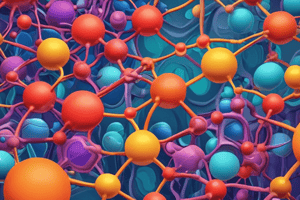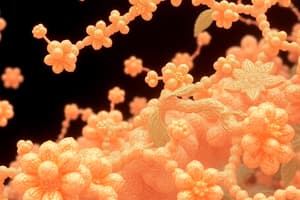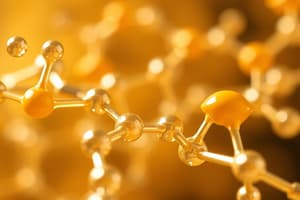Podcast
Questions and Answers
What is the primary function of lipids?
What is the primary function of lipids?
- Transportation of nutrients
- Energy storage (correct)
- Structural support
- Cell signaling
Lipids release 9 calories per gram when metabolized for energy.
Lipids release 9 calories per gram when metabolized for energy.
True (A)
Name the three components that make up a phospholipid.
Name the three components that make up a phospholipid.
2 fatty acids and 1 phosphate group
Lipids are composed of the elements C, H, and ___.
Lipids are composed of the elements C, H, and ___.
Match the following types of proteins with their functions:
Match the following types of proteins with their functions:
Which macromolecule primarily serves as short-term energy storage?
Which macromolecule primarily serves as short-term energy storage?
Polymers are usually composed of monomers.
Polymers are usually composed of monomers.
What process breaks down polymers into monomers?
What process breaks down polymers into monomers?
The monomer of carbohydrates is called a ______.
The monomer of carbohydrates is called a ______.
What is the primary function of nucleic acids?
What is the primary function of nucleic acids?
What is the primary function of carbohydrates?
What is the primary function of carbohydrates?
Proteins can provide energy and are commonly used as the first source of energy for the body.
Proteins can provide energy and are commonly used as the first source of energy for the body.
What are the monomers of nucleic acids?
What are the monomers of nucleic acids?
Match the following terms related to carbohydrates:
Match the following terms related to carbohydrates:
Proteins are composed of carbon, hydrogen, oxygen, nitrogen, phosphorus, and _____ .
Proteins are composed of carbon, hydrogen, oxygen, nitrogen, phosphorus, and _____ .
What is produced during a dehydration reaction?
What is produced during a dehydration reaction?
Carbohydrates are composed of the elements ______, ______, and ______.
Carbohydrates are composed of the elements ______, ______, and ______.
Match the protein structure levels with their definitions:
Match the protein structure levels with their definitions:
How many calories do proteins provide per gram?
How many calories do proteins provide per gram?
DNA contains the instructions for making proteins.
DNA contains the instructions for making proteins.
What are the building blocks of proteins called?
What are the building blocks of proteins called?
Flashcards
Macromolecules
Macromolecules
Large organic molecules (containing carbon) that make up all living things.
Monomers
Monomers
Small, basic sub-units that make up larger molecules.
Polymers
Polymers
Larger complex structures composed of many monomers linked together.
Dehydration reaction
Dehydration reaction
Signup and view all the flashcards
Hydrolysis
Hydrolysis
Signup and view all the flashcards
Monosaccharides
Monosaccharides
Signup and view all the flashcards
Polysaccharides
Polysaccharides
Signup and view all the flashcards
What is the main function of carbohydrates?
What is the main function of carbohydrates?
Signup and view all the flashcards
What is a phospholipid?
What is a phospholipid?
Signup and view all the flashcards
What is a triglyceride?
What is a triglyceride?
Signup and view all the flashcards
What are lipids composed of?
What are lipids composed of?
Signup and view all the flashcards
What is unique about a phospholipid?
What is unique about a phospholipid?
Signup and view all the flashcards
What are the various functions of proteins?
What are the various functions of proteins?
Signup and view all the flashcards
What is protein?
What is protein?
Signup and view all the flashcards
What is an amino acid?
What is an amino acid?
Signup and view all the flashcards
What is a polypeptide?
What is a polypeptide?
Signup and view all the flashcards
What defines the primary structure of a protein?
What defines the primary structure of a protein?
Signup and view all the flashcards
What defines the secondary structure of a protein?
What defines the secondary structure of a protein?
Signup and view all the flashcards
What defines the tertiary structure of a protein?
What defines the tertiary structure of a protein?
Signup and view all the flashcards
What defines the quaternary structure of a protein?
What defines the quaternary structure of a protein?
Signup and view all the flashcards
How does a protein's structure determine its function?
How does a protein's structure determine its function?
Signup and view all the flashcards
Study Notes
Macromolecules Overview
- Macromolecules are large organic molecules containing carbon, making up all living things
- Examples include carbohydrates, lipids, proteins, and nucleic acids
- Living things cannot survive without macromolecules
- These molecules perform various functions, including running the body, carrying information for bodily functions, and providing energy
- The rest of the semester's material will correlate with macromolecules
Structure Overview
- Monomers are small basic subunits, like individual bricks or single words
- Polymers are larger, more complex structures formed from monomers, like a brick wall or a sentence
Polymer Formation (Dehydration Reaction)
- Dehydration reaction links monomers to build polymers by removing a water molecule
- During dehydration, excess glucose is converted into glycogen for storage
Polymer Breakdown (Hydrolysis)
- Hydrolysis breaks down polymers into monomers by adding water
- This process occurs in the digestive system, breaking down complex starches into simpler sugars
Carbohydrates
- Main Function: Short-term energy storage
- Other Uses: Structure, transport, and signaling
- Found In: Sugars and starches
- Composition: Carbon (C), Hydrogen (H), and Oxygen (O)
- Monomer: Monosaccharides (single sugars) - Examples include glucose, fructose, and galactose
- Polymer: Polysaccharides (larger sugar molecules) - Examples include starch and glycogen (animal storage), and cellulose (plant cell wall support).
- Energy Storage: 4 calories/gram
Lipids
- Main Function: Long-term energy storage
- Other Uses: Insulation, protection, and structure
- Found In: Fats, oils, phospholipids (in cell membranes), and steroids
- Composition: Carbon (C), Hydrogen (H), and Oxygen (O)
- Monomer: Fatty acids
- Polymer: Triglycerides
- Energy Storage: 9 calories/gram
Phospholipids
- Structure: Two fatty acids and one phosphate group
- Hydrophilic head (phosphate group): Water-loving
- Hydrophobic tails (fatty acids): Water-hating
- Phospholipid Bilayer: Two layers making up cell plasma membranes
- Selectively Permeable: Controls what enters and leaves the cell
Proteins
- Main Function: Perform many functions necessary for survival due to flexibility and diversity
- Functions: Enzymes (speed up reactions), hormones (regulate processes), structural components (like bones and muscles), transporting materials (like hemoglobin), aiding in immune responses (antibodies), movement (contractile proteins), signaling (receptors).
- Found In: Meats, nuts, and dairy
- Composition: Carbon (C), Hydrogen (H), Oxygen (O), Nitrogen (N), and sometimes Phosphorus (P)
- Monomer: Amino acids
- Polymer: Polypeptide, chains of amino acids linked by peptide bonds
- Energy Storage: 4 calories/gram
Protein Structure
- The structure of a protein dictates its function
- The protein's shape determines its purpose
Nucleic Acids
- Main Function: Store, transmit, and express genetic information; instructions for making proteins
- Found In: DNA and RNA
- Composition: Carbon (C), Hydrogen (H), Oxygen (O), Nitrogen (N), and Phosphorus (P)
- Monomer: Nucleotides (Adenine, Guanine, Thymine, Cytosine, and Uracil)
- Polymer: Nucleic acid (DNA or RNA)
- Energy Storage: 0 calories/gram
Studying That Suits You
Use AI to generate personalized quizzes and flashcards to suit your learning preferences.




